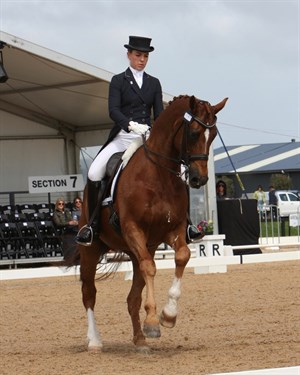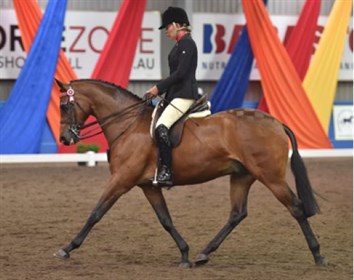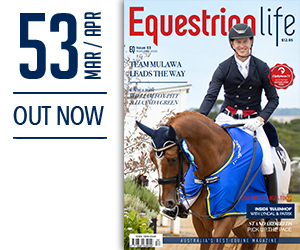
This article has appeared previously with Equestrian Life. To see what is in our latest issue, please click here.
Robbie McKinnon and Robali Razzamatazz.
© Roger Fitzhardinge
The Warmbloods are coming!
BY ROBBIE MCKINNON
I HAVE ALWAYS been pro-Warmblood, even though I have ridden all kinds of breeds over time. I started off in the dressage arena with a Cremello horse that was half stockhorse. There are different breeds for different disciplines, but the Warmblood is bred specifically for performance. They are obviously very sought after in the dressage arena, but for me crossing over to the show ring is natural; it is a dressage-based sport too. It is a sport where you need a good- looking horse with manners and movement. Warmbloods are definitely my choice for rider classes as they have the substance to carry you better. As a performance-bred horse they are certainly a good horse to cross over between the two disciplines.
Good conformation is very important for both the show ring and the dressage arena. A dressage horse needs to have strength for carrying ability and the potential to go up the levels to Grand Prix. And in the show ring it is all about looks; how well put together is the horse? Is it balanced front to back? Is it elegant? A short, stocky neck is not what you are after.
I like a horse with a bit more substance, that’s why I prefer Warmbloods. Conformation-wise, I feel that a really good-looking Warmblood can be as competitive as a good-looking Thoroughbred. Yet it can go both ways; a lot of Warmbloods - like some of mine - are crossed with a Thoroughbred, so you get more of the refinement required for the show ring. The combination with Warmbloods also gives fantastic temperament, not as fiery as some purebred Thoroughbreds.
A Thoroughbred is bred to race, and it can be challenging transitioning from the racecourse to the show ring. The cross with the Warmblood tends to give them more trainability and they are a bit easier to reason with. Movement is also big thing for me. Because I do dressage as well, I like to see? a really soft-moving horse. In the show ring this adds to a really appealing picture; if they move well and go softly, it is very elegant and beautiful to watch.
I have ridden quite a few Thoroughbreds in the show ring as well, and a lot of people have mentioned to me that they like the fact that they are fiery looking, their veins are popping out of their neck, they are really “on show”.
But I think, as many showies know, it takes a lot to get them into the ring. They need a lot of work, experience and dedication. The Warmblood tends to be a little more reliable and balanced, which is especially important for rider classes. There’s certainly a look you get from a Thoroughbred, which is very awake and eye-catching, but not everyone can handle that personality. Especially for teenagers coming off ponies, going from a pony on to an off-the-track Thoroughbred can be quite hard. The balance of having a bit more Warmblood in their pedigree can make it easier for a younger rider to handle.
It depends on the judge whether bigger movement equals a bigger advantage. Some judges prefer Warmbloods, some prefer Thoroughbreds. In the rider classes a bigger trot can be more eye-catching. However, sometimes you see people who can’t handle this bigger movement yet. It is not easy to sit on a huge moving horse. There are horses for courses and it is important for people to note that when they are buying horses. With Warmbloods becoming more popular in the show ring, it is vital that you don’t “over- horse”. You often see a lot of younger riders on horses that are too much for them. It is a bit of a trend, but it doesn’t make it any better.
At Robali Equestrian, we sell horses as well, and we have a lot of people who are after that transition horse that they can do both dressage and show ring with. We had a few young riders do that; they bought a Warmblood that is pretty enough to do show hunters and the show ring with, they can do their rider classes on it, and also learn the ropes of pure dressage. Being able to cross over is appealing for a lot of people, and if you want to do both the Warmblood is the way to go. It makes for a really good all-round horse.
Francesca Christie.
© Derek O'Leary
Give me a Thoroughbred!
BY FRANCESCA CHRISTIE
MY PREFERENCE WILL always be the Thoroughbred and I have a year-long experience with them in the show ring. They have the elegance and are the true show horses. I believe a show horse should be right on the edge, constantly “on show”. Warmbloods are relatively new in this sport. They are better suited for dressage, show jumping and eventing; they are a different style of horse. While they have always been represented in the breed classes, they don’t have the refinement of the Thoroughbred.
I find that a lot of Warmbloods entered in showing probably haven’t quite made it as a dressage horse. For training purposes, I just love the Thoroughbred. They only have to learn that they are not racing any more and they already have that extra edge. I find that the Warmblood is a slower-learning horse; their brain is very different to a Thoroughbred’s. A Thoroughbred brain is a lot quicker, which I like. However, a lot of people haven’t had the experience and that understanding with the Thoroughbred, so they find Warmbloods are quieter. I have been working with Thoroughbreds all my life. I was brought up on a Thoroughbred stud farm and have been involved with them in racing as well. So the transition was not very difficult for me.
I recruit off-the-track horses from all over Australia and I love a horse that has won a race or two, because they have that ability to look after themselves and are a step ahead of the others. My current horse, Eye of the Tiger (Relentless Lad, by Anabaa) placed well in many country cups and finished his career winning a cup. I bought into him when he was still a racehorse; he didn’t retire because he was a tired and finished-off horse.
People can get confused by what I say. I love dressage; I have ridden Grand Prix level dressage and have worked with Warmbloods as well, but I find them a little bit thicker in the brain. If you can afford that special Warmblood to compete at Grand Prix level, you are talking about a totally different animal to what we need in the show ring. I find a lot of these Warmbloods are lacking in the canter; they have a good trot but the canter is not good enough, and that’s why I presume they are not competing in dressage events. I am sure that is the same with a lot of Thoroughbreds, but the difference is particularly noticeable in the canter.
As we get more people who haven’t had the experience with Thoroughbreds, it is easier for them to ride Warmbloods. They are not after the characteristics that I like. Many Warmbloods would have already received some dressage training, and the ones that don’t make it to the higher level dressage get sold as a show horse mount.
At the moment there is a lot of confusion as to what a show horse is. There’s a big push on Warmbloods because so many have been bred, and they have to find a home somewhere. The Hunter classes brought out the Warmbloods initially. But once again, is it really a true hunter? A hunter has to be able to gallop, and is also meant to be able to negotiate muddy terrain...
Some judges can be easily impressed by the expressive movement and overlook typical show horse qualities. A hack is a very different animal to a dressage horse. To me a hack is the Elle Macpherson of the show horse world. They are meant to be extremely beautiful, refined and elegant. The Warmblood cuts a different picture to that. They show the flashy trot, but if you look a bit further they just don’t present the same picture in an open hack ring. A person riding a Thoroughbred in a rider class is a very different look from one riding a Warmblood. I am judging it for what it is, a show horse class, not a dressage class.
Warmbloods did have their breed specific classes. Now that a lot of people are getting involved with them, it has even changed the style of rider classes. There a lot of new people entering into the industry, riders and horses are changing. The beautiful, quality Thoroughbreds are harder and harder to find. About five years ago, you had five or six top horses lining up in the one class, now you? are lucky to get one. But for me, you can’t beat a magnificent Thoroughbred when they compete in the ring. You stand it next to a Warmblood and the Warmblood will always look coarse. Even with the most beautiful ones that have shown there’s a lot more horse to them. It is not as appealing to me as the Thoroughbred look and feel.
https://www.equestrianlife.com.au/articles/Changing-of-the-guard


